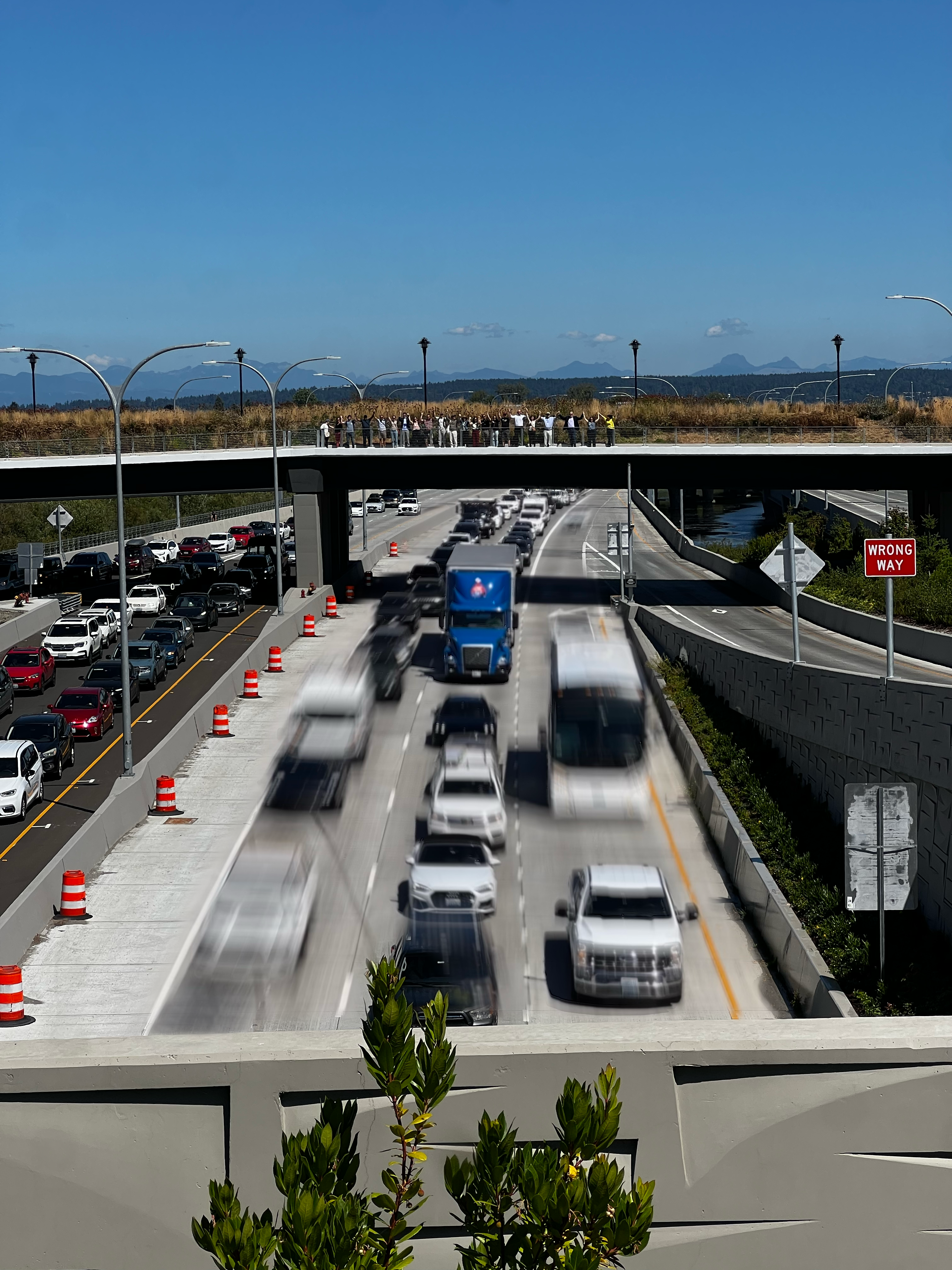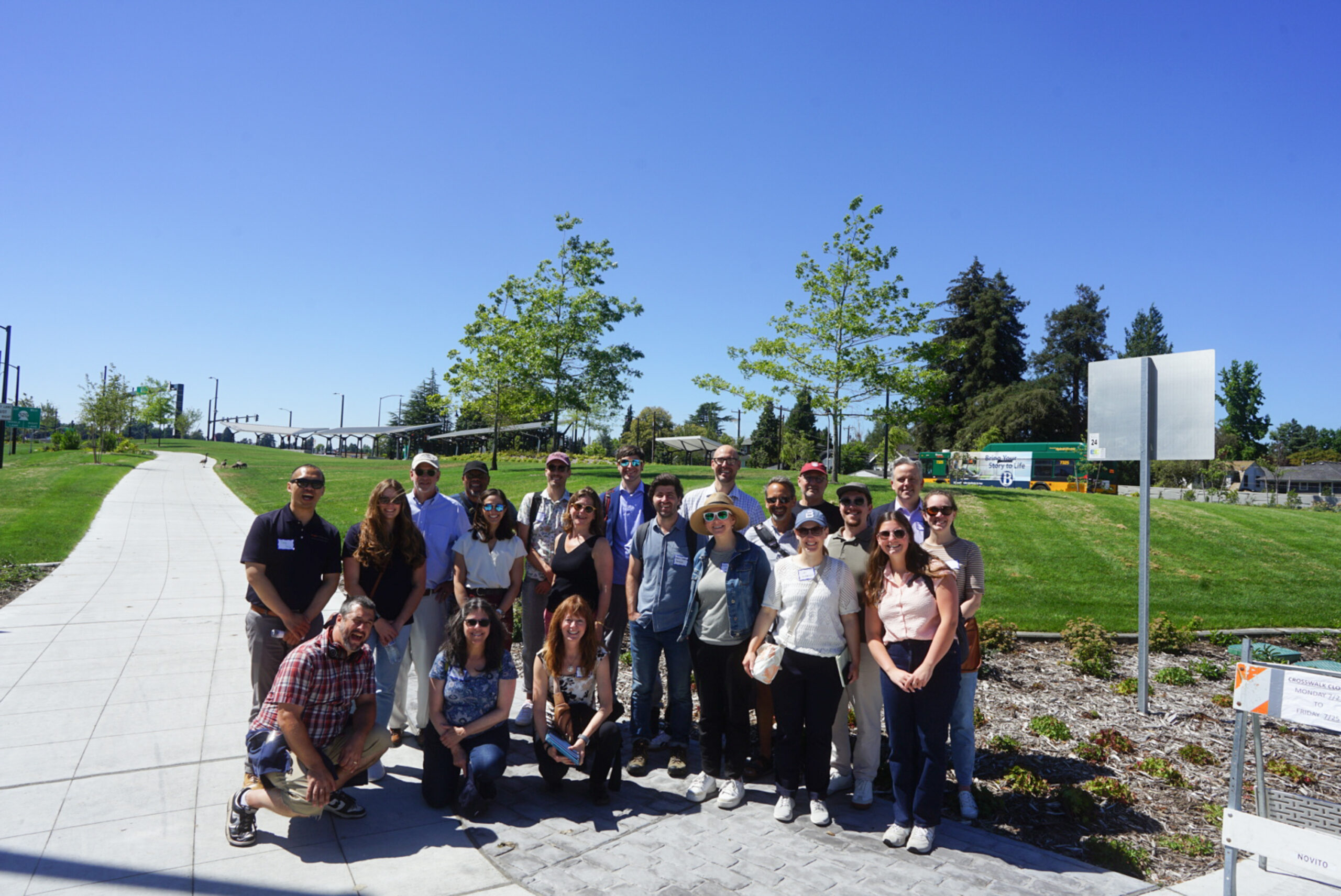StoriesUDP News
Lid I-5 North Coalition Hosts Reconnecting Communities Institute in the U District
August 5, 2025

On a bike, the Montlake Lid feels almost like a secret. One moment, you’re gliding past wildflowers and views of Lake Washington; the next, you realize six lanes of SR 520 traffic are humming beneath your wheels. Opened in early 2025, this green lid reconnects the Montlake neighborhood to the Arboretum and the U District — transforming a busy highway into a place where walking and biking feel natural.
For the Lid I‑5 North Coalition, this project is more than a park; it’s a preview of Seattle’s future. The community‑driven coalition envisions capping I‑5 between NE 45th and NE 50th Streets to reconnect the U District, Wallingford, Green Lake, Ravenna, and Roosevelt communities that were divided in the 1960s by a highway designed to prioritize cars over neighborhood connections. Montlake’s new lid offers a glimpse of how all these needs can be met through careful design.
 The Bridge and the Lid
The Bridge and the Lid
As part of the Washington State Department of Transportation’s $6.2 billion SR 520 Bridge Replacement and HOV Program, the Montlake Lid replaces seismically vulnerable highway structures while re-stitching the neighborhood’s connection to the water. Its land bridge and three acres of open space link the Arboretum, East Montlake Park, and the Burke‑Gilman and 520 trails, creating both a recreational destination and a critical mobility hub where pedestrian paths, bike trails, and transit lines come together.
Despite all this complexity, the land bridge feels surprisingly intimate and human-scaled. The wide, gently curving path is perfect for side‑by‑side walking or casual cycling. Grassy mounds and wildflowers soften wind and highway noise, while engineered soils support shade trees that make the space feel like a natural extension of the Arboretum. It’s quiet. Lake Washington sparkles in the distance, and for a moment, it’s easy to forget the traffic below.
After the bridge, the experience shifts. To the left, East Montlake Park offers a path to a kayak launch under the 520 bridge. To the right, the lid opens into a public green framed by four busy streets. In this 3-acre lawn, the highway’s legacy is harder to ignore: oversized sidewalks, truck‑scale signage, and traffic on all sides make the space feel exposed and temporary. It’s a space to pass through, rather than linger.
That is, of course, unless you happen to be on a bike. Biking seems to be the best way to mediate the tug-of-war between the car-scaled and human-scaled design at Montlake. The flowers, trees, and views are still just as enjoyable, and now the signs and traffic fade to the periphery. Riding here feels like a safe respite from navigating the streets around the busy interchange. In coming years, the lid will complete a key connection between the Burke‑Gilman Trail and the 520 Bridge path—turning a former freeway barrier into a seamless part of the regional bike network that takes riders from Puget Sound shores to the foothills of the Cascades.
A Project Decades in the Making
But the human scale is about more than height. It’s also about time. Although the Montlake Lid opened in 2025, the first conversations about the project began in the early 1990s. Over three decades, the project inched forward through changes in administrations, funding streams, and neighborhood stakeholders. “I’ve been working on this project for my entire career, and it started the year I was born,” said Amanda Newton, PE, a bridge engineer with TYLin.
That long timeline is typical for major infrastructure projects. Big visions need champions, and successful highway lids rely on continually building capacity for the next generation of leaders who will see them through. Nationally, the U.S. Department of Transportation’s Reconnecting Communities Institute is supporting this work by offering technical assistance to nonprofits, local governments, and Tribes working to repair the damage caused by highway infrastructure.
As part of the Lid I-5 North Coalition, The U District Partnership is currently participating in a six‑city learning cohort—including Syracuse, St. Paul, Indianapolis, Oakland, and Vancouver—focused on planning, funding, and delivering these transformative projects. Last week, cohort members visited Seattle to learn directly from local engineers, planners, and community leaders about the newly completed Montlake Lid. TYLin engineers Tony Nguyen and Amanda Newton—alongside urban designer Lyle Bicknell, landscape architect Jason Henry, and urban planners Cayce James and Tiernan Martin—offered presentations on the structural, financial, and community challenges of the project. The day ended with a walking tour of the lid and a visit to Seattle’s original freeway cap, led by Scott Bonjukian, co‑chair of the Lid I‑5 effort in Downtown Seattle.
Building for the Next Fifty Years
The work on Seattle’s freeways is only beginning. Built in the 1960s, I‑5 now requires major preservation and seismic upgrades. Over the next several years, the Washington State Department of Transportation’s “Revive I‑5” program will replace pavement, expansion joints, and strengthen bridges against earthquakes. Local leaders, however, see this necessary maintenance as a chance to do something bigger.
Urban designer and Lid I‑5 North co‑chair Stephen Antupit views the overlap with the upcoming U District Subarea Plan as an opportunity to rethink how we make urban neighborhoods places that work for everyone. “We have to start building the city we want fifty years from now,” Antupit said. “We can’t do that if we keep rebuilding our aged, seismically-outdated highways as the defining infrastructure that tore our cities apart fifty years ago.” His fellow co‑chair, community advocate Winston Saunders, imagines starting with bold, human‑scale ideas instead of simply repeating car‑centric designs. “The Montlake Lid is a giant leap toward healing the 520 Freeway divide between Montlake and the University of Washington” he said. “We can integrate these lessons to lid I‑5 North and meet transportation, recreation, housing, and business‑development needs of our thriving neighborhoods and city.”
Interested in learning more or getting involved? Sign up for the Lid I-5 North mailing list here.
